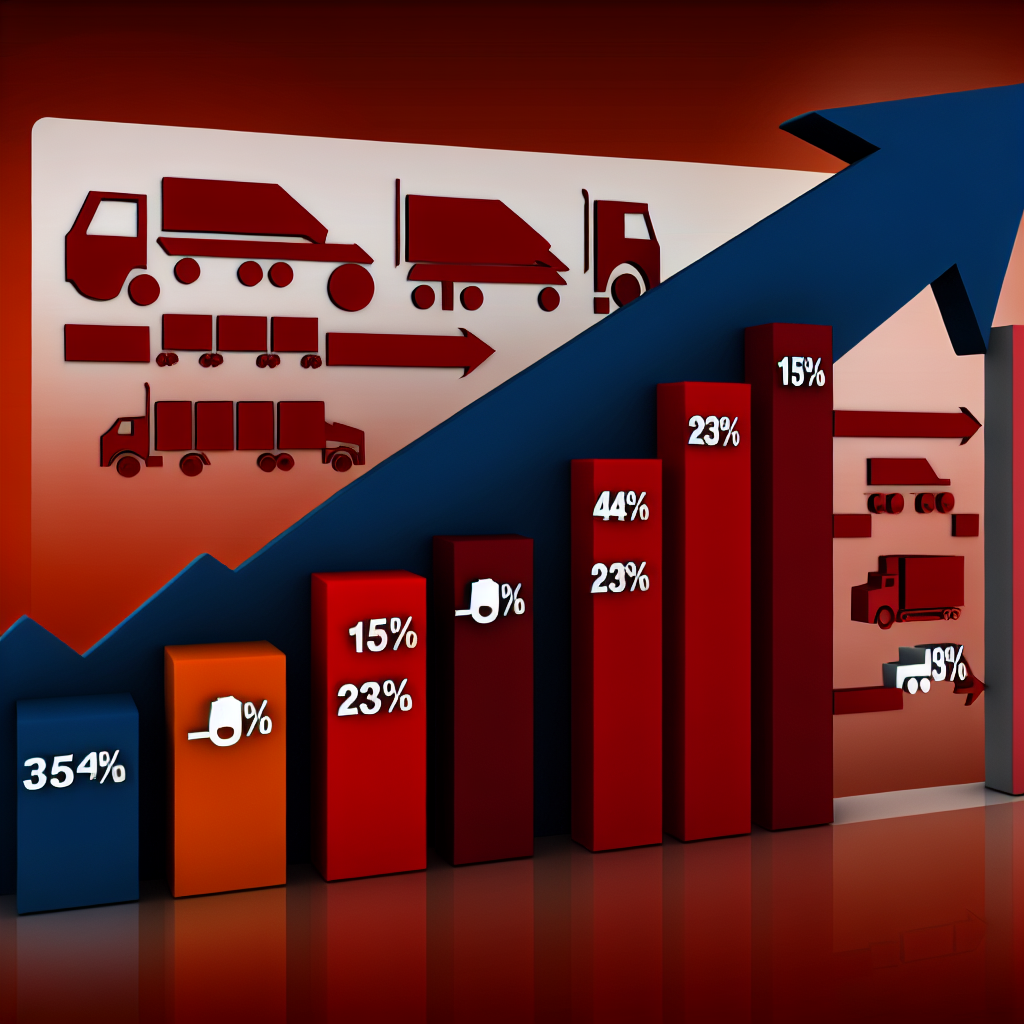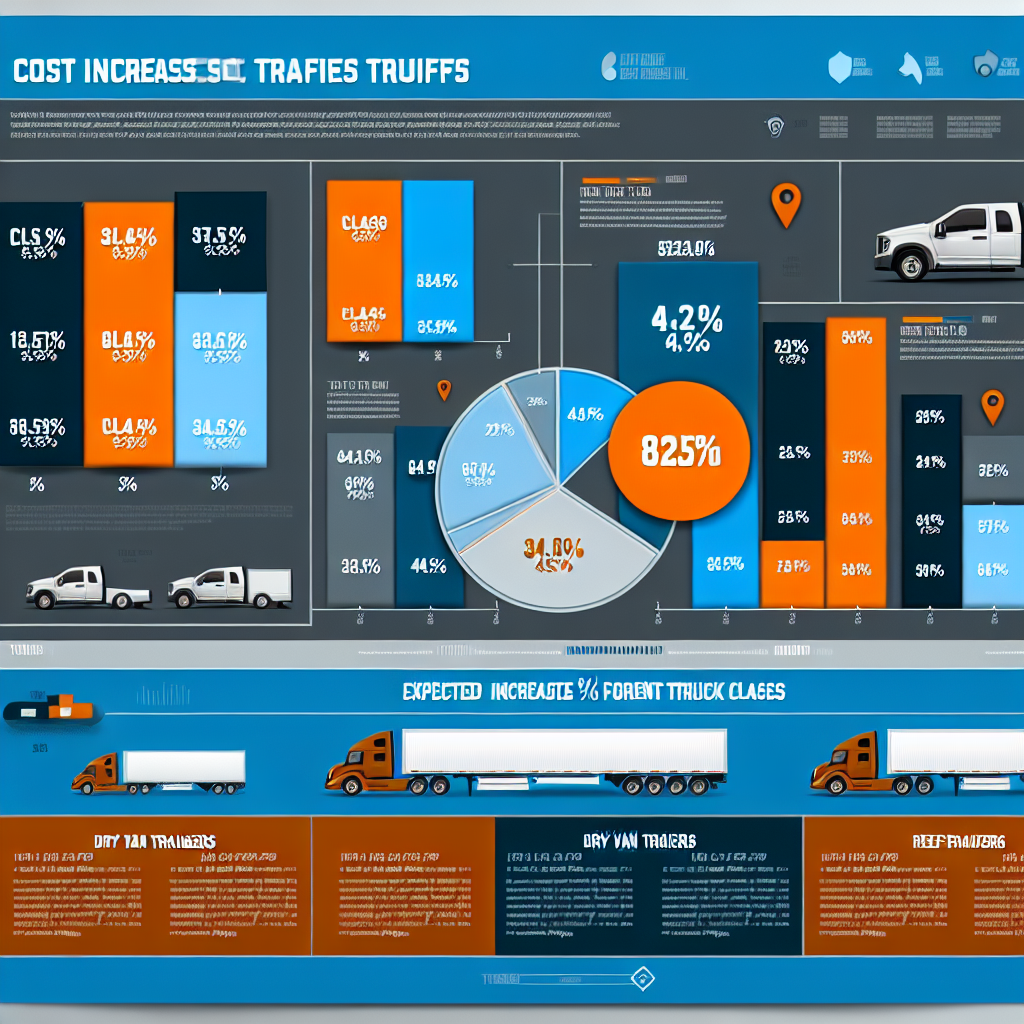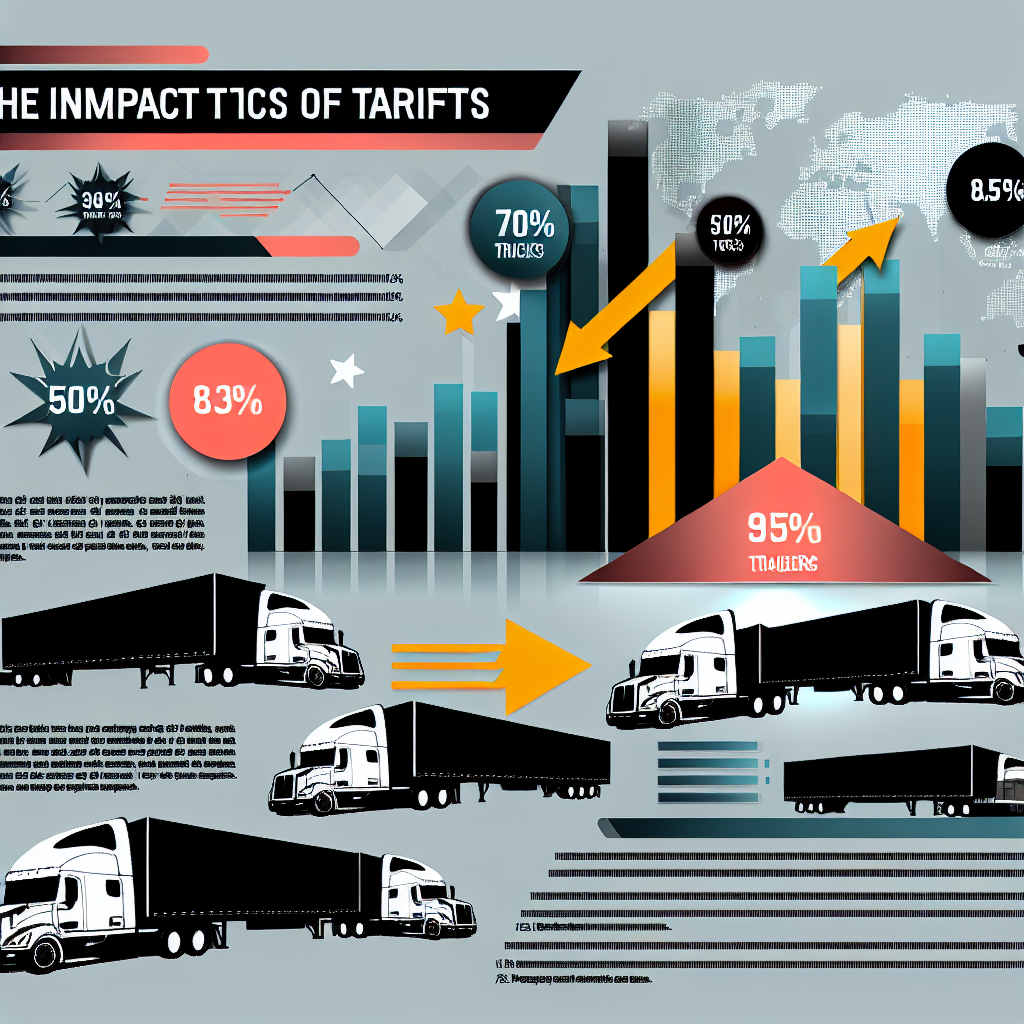In the ever-evolving landscape of the trucking industry, the specter of tariffs on equipment buyers now looms large, casting a shadow over fleets striving for profitability.
With increased costs expected from tariff surcharges that could range from 15 to 30 percent on various truck categories, including Class 8 trucks and heavy-duty trailers, the financial burdens are more profound than ever. These surcharges are not just numbers on a balance sheet; they translate into significant implications for equipment finance companies and the operational viability of many fleets.
As companies attempt to navigate these turbulent waters, the challenge remains clear: How can fleets adapt to maintain their competitive edge while grappling with rising acquisition costs? This moment calls for vigilant strategies and foresight in the face of mounting expenses that threaten to redefine the parameters of successful fleet management.
Therefore, understanding the intricacies of equipment costs and the pervasive impact of these tariffs is imperative for stakeholders at every level.

In light of the recent downturn in the freight market, trailer manufacturers are faced with significant challenges due to decreased demand for new trailers. According to Truck News, the July order figures indicated a staggering 39% decline in new trailer orders compared to June, resulting in overall order activity decreasing by 5% during the ongoing order season. FTR has projected a further reduction in trailer production, estimating a decrease from 230,000 units in 2024 to 187,000 in 2025, starkly down from 314,000 units in 2023.
Trailer manufacturers are responding to this decline with distinct adaptation strategies. They are managing production rates carefully to prevent oversupply, while simultaneously diversifying their supply chains to mitigate the impact of tariffs on materials like steel and aluminum. As reported, tariffs are anticipated to raise prices for certain trailers by 16 to 28%, leading to hesitation among fleets to replace aging equipment. Notably, Charles Dutil, CEO of Manac, indicated that carriers often suspend purchases during economic downturns, opting instead to extend the life of their current equipment.
Additionally, fleet operators are shifting their strategies in response to these economic pressures. They are delaying trailer replacements and exploring cost mitigation strategies. In light of tariff-induced price increases, fleets are also considering diversified procurement models, leaning towards leasing instead of outright purchases. This strategic pivot allows fleets to maintain operational flexibility while navigating the unpredictability surrounding equipment costs.
As manufacturers focus on maintaining transparent communication with suppliers, the aim is to better manage production capacities and align with future demand, setting the stage for recovery when market conditions improve. The overall strategies adopted by both trailer manufacturers and fleet operators illustrate a dynamic response to current financial challenges rooted in the interplay of reduced demand and rising costs stemming from tariffs.
| Truck Class | Expected Percentage Increase in Costs Due to Tariffs |
|---|---|
| Class 8 | 15-24% |
| Classes 4-7 | 15-23% |
| Dry Vans | 16-28% |
| Reefers | 16-28% |
| Other Heavy-Duty | 17-30% |
In the evolving landscape of the trucking industry, the impact of tariffs on equipment buyers has become increasingly pronounced. Recent analysis indicates that tariffs will add substantial costs to various classes of trucks and trailers. Specifically, expectations estimate an increase ranging from 15 to 24 percent for Class 8 trucks, reflecting a significant financial burden for fleets that are already operating under tight margins.
To further clarify the challenges at hand, it is noteworthy that for Classes 4 to 7 trucks, the tariff-related cost increases are anticipated between 15 and 23 percent. Moreover, dry van and reefer trailers can expect price hikes ranging from 16 to 28 percent, while other heavy-duty trailers face increases of 17 to 30 percent. This data underscores the ripple effect tariffs have on the trucking industry, as these costs are likely to be passed down to consumers and shippers alike, contributing further to operational expenses.
Transitioning into the discussion of strategic solutions, it is imperative for fleet managers to comprehend the full scope of these financial implications. The American Trucking Associations (ATA) emphasizes that a 25 percent tariff on imports from Mexico could raise the price of a new tractor by as much as $35,000. This reality poses a considerable obstacle for smaller carriers, potentially making new equipment purchases prohibitive and leading to increased operational costs of tens of millions for larger fleets overall. The financial implications extend beyond just buying new trucks; they affect the entire operational ecosystem of trucking businesses.
Furthermore, the market has reacted to these uncertainties. In February 2025, Class 8 truck orders plummeted to 17,000 units—a 31 percent month-over-month decrease and a 38 percent year-over-year decline. This downturn signals buyer hesitance amid concerns about escalating costs due to tariffs, which have instilled a cautious approach among fleet operators when it comes to making purchasing decisions.
In summary, the current tariff landscape is reshaping the financial framework within which equipment buyers operate, leading to increased costs across multiple truck classes, a decline in new unit orders, and a heightened sense of uncertainty about the future. As such, equipment buyers must navigate these challenges carefully, balancing their needs against the backdrop of rising acquisition costs.
Strategic Cost Management Solutions
As fleets navigate the challenges posed by increasing equipment costs due to tariffs, several strategic solutions can provide actionable pathways to manage these financial pressures effectively. Here are key strategies that fleet managers can adopt:
- Diversify Supply Chains
Reducing reliance on high-tariff regions by sourcing materials from countries with lower tariffs can effectively decrease production costs. This geographic diversification minimizes dependency on specific suppliers, ensuring a more stable and cost-effective supply chain. - Optimize Procurement Timing
Strategic timing of equipment orders is critical. For instance, ordering trucks before significant tariff dates can help avoid exorbitant fees and price increases from OEMs. Acting promptly at advantageous times could save substantial amounts over time, especially for larger orders. - Implement Preventive Maintenance Programs
Establishing a robust preventive maintenance schedule can help prolong vehicle lifespan and avoid costly emergency repairs, ultimately reducing long-term operational costs. Regular servicing ensures that vehicles remain compliant and efficient, minimizing downtime. - Leverage Fleet Management Technology
Utilizing telematics and GPS tracking systems allows for real-time monitoring of vehicle performance, helping to optimize routes, fuel usage, and overall fleet efficiency. The data collected can significantly drive down operational costs through informed decision-making. - Evaluate Leasing vs. Purchasing
Carefully considering whether to lease or buy vehicles offers financial flexibility. Fleets should explore leasing arrangements or flexible financing options to manage cash flow effectively and hedge against sudden expenditure spikes due to tariffs. - Explore Alternative Fuel Vehicles
Transitioning to alternative fuel options, such as electric or compressed natural gas vehicles, can reduce fuel costs and enhance sustainability. Newer models typically offer better performance, lower maintenance costs, and potential government incentives which can provide significant long-term savings. - Strengthen Supplier Relationships
Building strong relationships with local dealers and service providers fosters better pricing and service agreements. Collaborating with insurance providers can also lead to tailored fleet policies that manage rising costs and premiums due to increased vehicle values.
By implementing these strategic approaches, fleets can effectively address the financial challenges posed by tariffs while positioning themselves for operational efficiency and sustained growth.

In conclusion, the trucking industry faces a critical juncture as it grapples with the profound impact of rising equipment costs due to tariffs. As financial burdens escalate, with projected increases of 15 to 30 percent across various truck classes, it becomes essential for fleet operators to adapt strategically. The urgency for proactive financial management and operational flexibility cannot be overstated.
While manufacturers and fleets navigate these challenges, the emphasis on strategic procurement and adaptive supply chain solutions will be the linchpin for future success. By leveraging technology and diversified supplier relationships, fleets can develop more resilient operations, helping to mitigate the financial impacts of increased tariffs.
Moreover, exploring leasing options and implementing preventive maintenance programs can significantly bolster financial health, ensuring operational continuity amidst rising costs. In this volatile environment, fostering a culture of innovation and adaptability is imperative. The collective efforts of industry stakeholders will ultimately define the path forward in navigating this complex landscape, balancing immediate concerns with long-term viability, and ultimately shaping the future of trucking in the face of ongoing challenges.
In the ever-evolving landscape of the trucking industry, the specter of tariffs on equipment buyers now looms large, casting a shadow over fleets striving for profitability. With increased costs expected from tariff surcharges that could range from 15 to 30 percent on various truck categories, including Class 8 trucks and heavy-duty trailers, the financial burdens are more profound than ever. These surcharges are not just numbers on a balance sheet; they translate into significant implications for equipment finance companies and the operational viability of many fleets. As Kyle Treadway, dealer principal at Kenworth Sales Company, stated, “We are hesitant (to order) because if the tariffs go away, we will have an expensive truck.” As companies attempt to navigate these turbulent waters, the challenge remains clear: How can fleets adapt to maintain their competitive edge while grappling with rising acquisition costs? This moment calls for vigilant strategies and foresight in the face of mounting expenses that threaten to redefine the parameters of successful fleet management. Therefore, understanding the intricacies of equipment costs and the pervasive impact of these tariffs is imperative for stakeholders at every level.
Tariff Impact on Different Truck Classes
| Truck Class | Expected Percentage Increase in Costs Due to Tariffs |
|---|---|
| Class 8 | 15-24% |
| Classes 4-7 | 15-23% |
| Dry Vans | 16-28% |
| Reefers | 16-28% |
| Other Heavy-Duty | 17-30% |
Industry stakeholders have expressed significant concerns regarding the impact of tariffs on trucking equipment and operational costs. Jonathan Randall, president of Mack Trucks North America, highlighted that despite building all trucks in the U.S., the company faces disadvantages compared to manufacturers producing in Mexico, as tariffs on imported components increase costs: “We are actually disadvantaged today versus some [OEMs] that are producing in Mexico.” Furthermore, Chris Spear, President & CEO of the American Trucking Associations (ATA), emphasized that a 25 percent tariff on Mexico could increase the price of a new tractor by up to $35,000. This possible escalation is particularly burdensome for small carriers and could add tens of millions of dollars in annual operating costs for larger fleets.
The current tariff landscape is reshaping the financial framework within which equipment buyers operate, leading to increased costs across multiple truck classes, a decline in new unit orders, and a heightened sense of uncertainty about the future. As Krista Toenjes, General Manager of North America On-Highway Business at Cummins, noted, every component must be assessed for its source and applicable tariff, complicating the manufacturing process. The financial implications extend beyond just buying new trucks; they affect the entire operational ecosystem of trucking businesses.
Strategic Cost Management Solutions
As fleets navigate the challenges posed by increasing equipment costs due to tariffs, several strategic solutions can provide actionable pathways to manage these financial pressures effectively. Here are key strategies that fleet managers can adopt:
- Diversify Supply Chains
Reducing reliance on high-tariff regions by sourcing materials from countries with lower tariffs can effectively decrease production costs. This geographic diversification minimizes dependency on specific suppliers, ensuring a more stable and cost-effective supply chain. - Optimize Procurement Timing
Strategic timing of equipment orders is critical. For instance, ordering trucks before significant tariff dates can help avoid exorbitant fees and price increases from OEMs. Acting promptly at advantageous times could save substantial amounts over time, especially for larger orders. - Implement Preventive Maintenance Programs
Establishing a robust preventive maintenance schedule can help prolong vehicle lifespan and avoid costly emergency repairs, ultimately reducing long-term operational costs. Regular servicing ensures that vehicles remain compliant and efficient, minimizing downtime.
Summary of Tariff Impacts
- Class 8 Trucks: Potential cost increase of 15-24% due to tariffs.
- Classes 4-7 Trucks: Expected cost rise between 15-23% from tariff surcharges.
- Dry Van Trailers: Tariff impacts could lead to price increases of 16-28%.
- Reefer Trailers: Anticipated price hikes also in the range of 16-28%.
- Other Heavy-Duty Trailers: Costs likely to rise by 17-30%.

Introduction to Equipment Financing and Tariff Impacts in the Trucking Industry
In the ever-evolving landscape of the trucking industry, the specter of tariffs on equipment buyers now looms large, casting a shadow over fleets striving for profitability.
With increased costs expected from tariff surcharges that could range from 15 to 30 percent on various truck categories, including Class 8 trucks and heavy-duty trailers, the financial burdens are more profound than ever. These surcharges are not just numbers on a balance sheet; they translate into significant implications for equipment finance companies and the operational viability of many fleets.
As companies attempt to navigate these turbulent waters, the challenge remains clear: How can fleets adapt to maintain their competitive edge while grappling with rising acquisition costs? This moment calls for vigilant strategies and foresight in the face of mounting expenses that threaten to redefine the parameters of successful fleet management.
Therefore, understanding the intricacies of equipment costs and the pervasive impact of these tariffs is imperative for stakeholders at every level.
Current Trucking Industry Trends and Rising Equipment Costs
As tariffs continue to influence the cost structure of the trucking industry, key trends are emerging. Notably, the demand for innovative leasing strategies is rising as fleets seek to mitigate costs.
Summary of Tariff Impacts
- Class 8 Trucks: Potential cost increase of 15-24% due to tariffs.
- Classes 4-7 Trucks: Expected cost rise between 15-23% from tariff surcharges.
- Dry Van Trailers: Tariff impacts could lead to price increases of 16-28%.
- Reefer Trailers: Anticipated price hikes also in the range of 16-28%.
- Other Heavy-Duty Trailers: Costs likely to rise by 17-30%.
Strategic Equipment Leasing Strategies in the Trucking Industry
As fleets navigate the challenges posed by increasing equipment costs due to tariffs, several strategic equipment leasing solutions can provide actionable pathways to manage these financial pressures effectively. Here are key strategies that fleet managers can adopt:
- Diversify Supply Chains
Reducing reliance on high-tariff regions by sourcing materials from countries with lower tariffs can effectively decrease production costs. This geographic diversification minimizes dependency on specific suppliers, ensuring a more stable and cost-effective supply chain. - Flexible Lease Terms and Short-Term Rentals
To accommodate fluctuating transportation needs, leasing companies are offering more adaptable solutions, including short-term rentals and flexible lease durations. This approach allows businesses to scale their fleets based on seasonal demand or specific project requirements. - Implement Preventive Maintenance Programs
Establishing a robust preventive maintenance schedule can help prolong vehicle lifespan and avoid costly emergency repairs, ultimately reducing long-term operational costs. Regular servicing ensures that vehicles remain compliant and efficient, minimizing downtime.
By implementing these strategic approaches, fleets can effectively address the financial challenges posed by tariffs while positioning themselves for operational efficiency and sustained growth.
